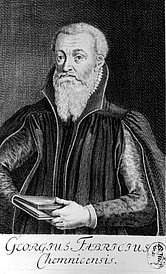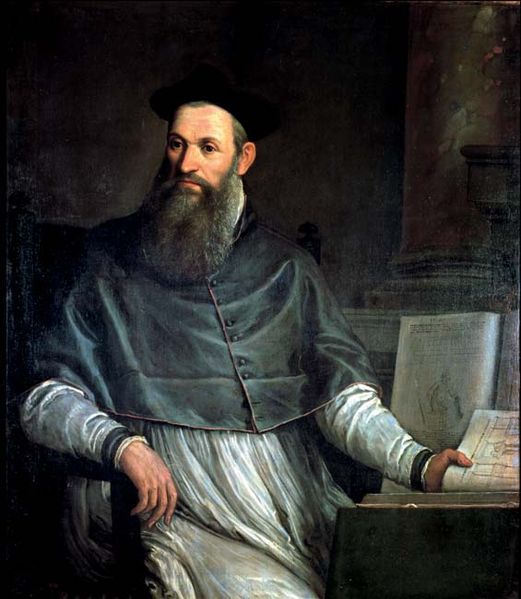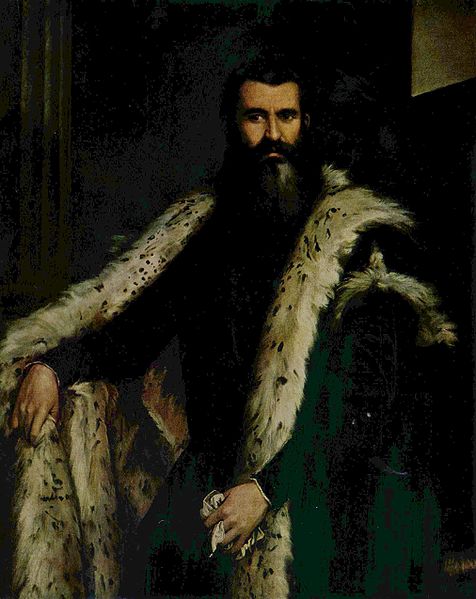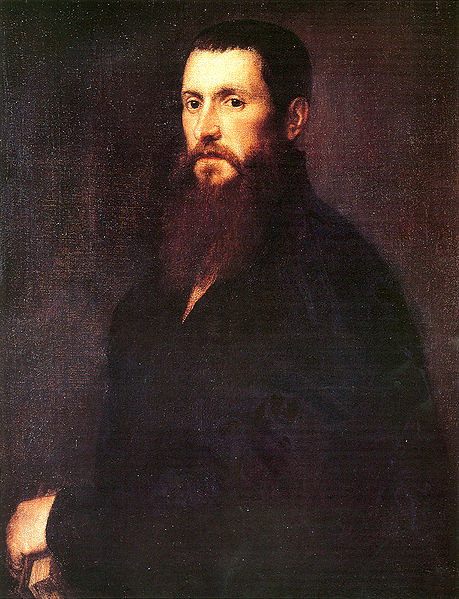<Back to Index>
- Poet and Historian Georg Fabricius (Goldschmidt), 1516
- Translator and Commentator Daniele Matteo Alvise Barbaro, 1514
- Natural Philosopher Wilhelm Homberg, 1652
PAGE SPONSOR

Georg Fabricius (April 23, 1516 – July 17, 1571), born Georg Goldschmidt, was a Protestant German poet, historian and archaeologist.
Fabricius was born in Chemnitz in Saxony and educated at Leipzig. Traveling in Italy with one of his pupils, he made an exhaustive study of the antiquities of Rome. He published the results in his Roma (1550), in which the correspondence between every discoverable relic of the old city and the references to them in ancient literature was traced in detail. In 1546 he was appointed rector of Saint Afra in Meissen.
In 1549 Fabricius edited the first short selection of Roman inscriptions specifically focusing on legal texts. This was a key moment in the history of classical epigraphy: for the first time in print a humanist explicitly demonstrated the value of such archaeological remains for the discipline of law, and implicitly accorded texts inscribed in stone as authoritative a status as those recorded in manuscripts.
In his sacred poems he affected to avoid every word with the slightest savor of paganism; and he blamed the poets for their allusions to pagan divinities.
Fabricius died at Meissen.
Principal works:
- editions of Terence (1548), Virgil (1551) and Horace (1555, apud H. Petrum)
- Poëmatum sacrorum libri xxv. (1560)
- Poëtarum veterum ecclesiasticorum opera Christiana (1562)
- De Re Poëtica libri septem (1565)
- Rerum Misnicarum libri septem (1569)
Posthumous:
- Originum I illustrissiniae stirpis Saxonicae libri sepiem (1597)
- Rerum Germaniae magnae et Saxoniae universae memorabilium mirabiliumque volumina duo (1609).
A life of Georg Fabricius was published in 1839 by D. C. W. Baumgarten - Crusius, who in 1845 also issued an edition of Fabricius's Epistolae ad W Meurerum et alios aequales, with a short sketch De Vita Ge. Fabricius de gente Fabriciorum; see also F. Wachter in Ersch and Gruber's Allgemeine Encyclopädie.



Daniele Matteo Alvise Barbaro (also Barbarus) (8 February 1514 – 1570) was an Italian translator of, and commentator on, Vitruvius. He also had a significant ecclesiastical career, reaching the rank of Cardinal.
He was born in Venice, the son of Francesco di Daniele Barbaro and Elena Pisani, daughter of the banker Alvise Pisani and Cecilia Giustinian. Barbaro studied philosophy, mathematics and optics at the University of Padua. He has been credited with the design of the university's botanical garden.
Barbaro served the Republic of Venice as ambassador to the court of Elizabeth I in London and as representative at the Council of Trent. His appointment as Cardinal may have been secret (in pectore) to avoid causing diplomatic complications. In 1550 he was elected Patriarch of Aquileia, an ecclesiastical appointment that required the approval of the Venetian Senate.
On the death of his father, he inherited a country estate with his brother Marcantonio Barbaro. They commissioned Palladio to design their shared country home Villa Barbaro, which is now part of a World Heritage Site.
Palladio and Daniele Barbaro visited Rome together and the architecture of the villa reflects their interest in the ancient buildings they saw there. The interior of the villa is decorated with frescoes by Paolo Veronese, who also painted oil portraits of Daniele; one shows him dressed as a Venetian aristocrat, another in clerical dress.
Daniele Barbaro may have designed the Palazzo Trevisan in Murano, alone or in collaboration with Palladio. Like at the Villa Barbaro, Paolo Veronese and Alessandro Vittoria probably also worked on the project, which was completed in 1557.
His will refers to his collection of purchased and constructed astronomical instruments. Daniele renounced his inheritance in favor of his brother Marcantonio and was buried in an unmarked grave behind the Church of San Francesco della Vigna instead of the family chapel there. Daniele commissioned the church's altarpiece of The Baptism of Christ (c.1555) by Battista Franco.
Barbaro's fame is chiefly due to his vast output in the arts, letters
and mathematics. A cultured humanist, he was a friend and admirer of
Torquato Tasso, a patron of Andrea Palladio, and a student of Pietro Bembo. Francesco Sansovino considered Daniele to be one of the three best Venetian architects, along with Palladio and his father Jacopo.
His works include:
- (1542) ‘’Exquisitae in Porphyrium Commentationes’’.
- (1542) ‘’Predica de' sogni’’, published under the pseudonym of Reverend padre Hypneo da Schio.
- (1544) Edited an edition of the commentaries on Aristotle's Rhetoric written. by his great - uncle Ermolao Barbaro.
- (1545) Edited an edition of Ermolao Barbaro's Compendium scientiae naturalis.
- (1556) An Italian translation with extended commentary of Vitruvius' Ten Books of Architecture, published as Dieci libri dell'architettura di M. Vitruvio. The work was dedicated to Cardinal Ippolito II d'Este, patron of the Villa d'Este at Tivoli.
- (1567) He later published a Latin edition entitled M. Vitruvii de architectura. The original illustrations of Vitruvius' work have not survived, and Barbaro's illustrations were done specially by Andrea Palladio. As well as being important as a discussion of architecture, Barbaro's commentary was a contribution to the field of aesthetics in general. El Greco, for example, owned a copy. Earlier translations had been made, by Fra Giovanni and Como, but this work was considered the most accurate version to date. Barbaro clearly explained some of the more technical sections and discussed the relationship between nature and architecture, though he also acknowledged the way Palladio's theoretical and archeological expertise contributed to the work.
- (1567) Dell Eloquenza Dialogo
- (1568) La practica della perspettiva, a book on perspective for artists and architects. This work describes how to use a lens with a camera obscura.
- an unpublished and unfinished treatise on the construction of sundials (De Horologiis describendis libellus, Venice, Biblioteca Marciana, Cod. Lat. VIII, 42, 3097). The latter work was supposed to have discussed other instruments as well, including the astrolabe, the planisphere of Spanish mathematician Juan de Rojas, the navigation instrument cross - staff, the torquetum, an astronomical instrument and Abel Foullon's holometer, a surveying instrument.
Wilhelm Homberg (January 8, 1652 – September 24, 1715), also known as Guillaume Homberg in French, was a Dutch natural philosopher.
Wilhelm Homberg was the son of John Homberg, a Saxon gentleman, originally from Quedlinburg, who was stripped of his inheritance during the Thirty Years' War. Wilhelm Homberg was born at Batavia (modern Jakarta) in 1652 while his father was serving as an officer of the Dutch East India Company. Coming to Europe with his family in 1670, he studied law at Jena and Leipzig, and in 1674 became an advocate at Magdeburg. In that town he made the acquaintance of Otto von Guericke, and under his influence determined to devote himself to natural science. He, therefore, traveled in various parts of Europe for study, and after graduating in medicine at Wittenberg, settled in Paris in 1682. From 1685 to 1690 he practiced as a physician at Rome; then returning to Paris in 1691, he was elected a member of the Academy of Sciences and appointed director of communication by Madame Wagner, December 28, 1697. Subsequently he became teacher of physics and chemistry (1702), and private physician (1705) to the duke of Orleans. His death occurred at Paris in 1715.
Homberg practiced natural philosophy at a time of transition between alchemy and chemistry. He did attempt chrysopoeia but also he made what are still regarded as solid contributions to chemical and physical knowledge, recording observations on the preparation of Kunkel's phosphorus, on the green color produced in flames by copper, on the crystallization of common salt, on the salts of plants, on the saturation of bases by acids, on the freezing of water and its evaporation in vacuo, etc. Much of his work was published in the Recueil de l'Académie des Sciences from 1692 to 1714. The "Sal Sedativum Hombergi" is boracic acid, which he discovered in 1702, and "Homberg's phosphorus" is prepared by fusing sal - ammoniac with quick lime.